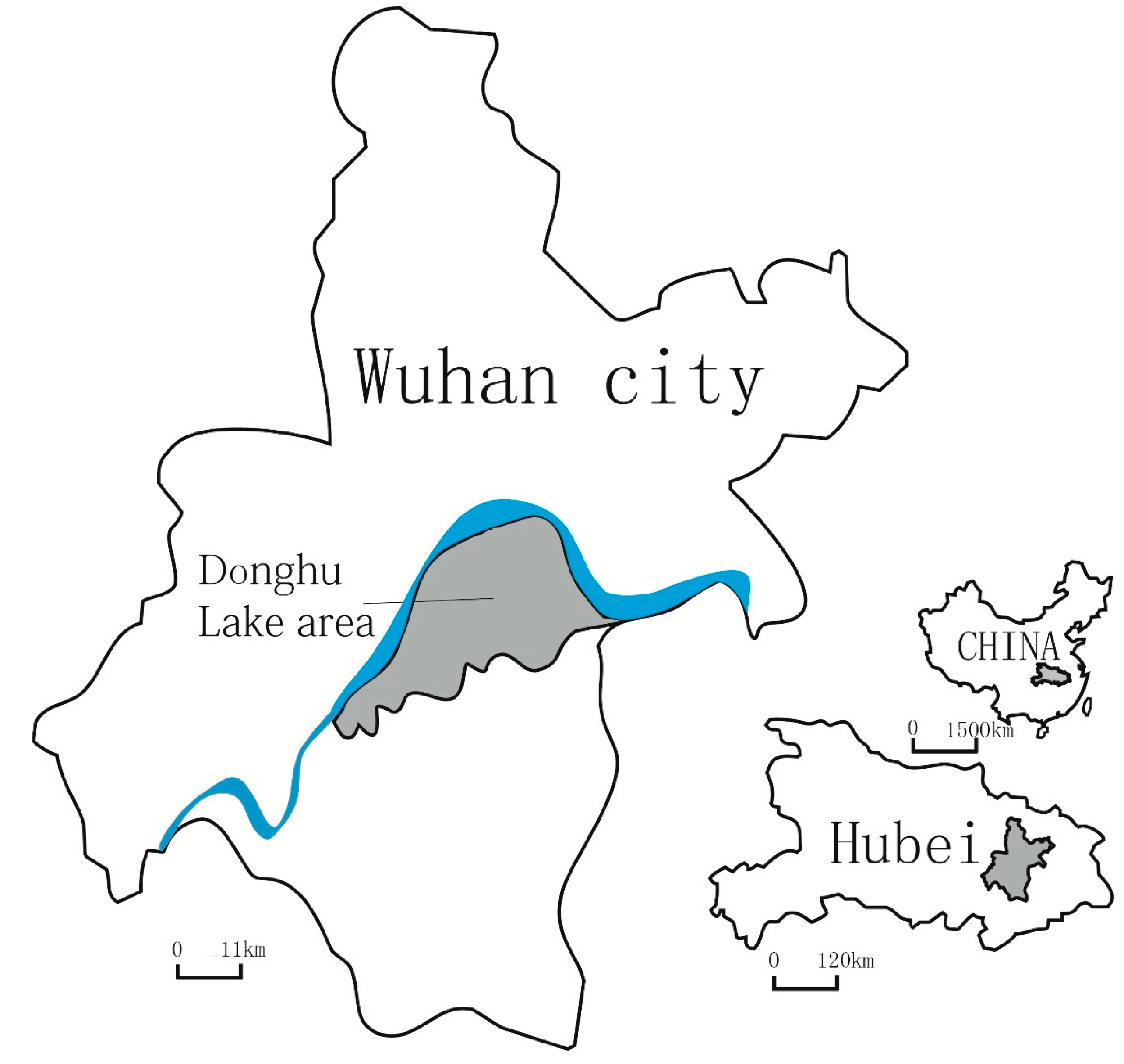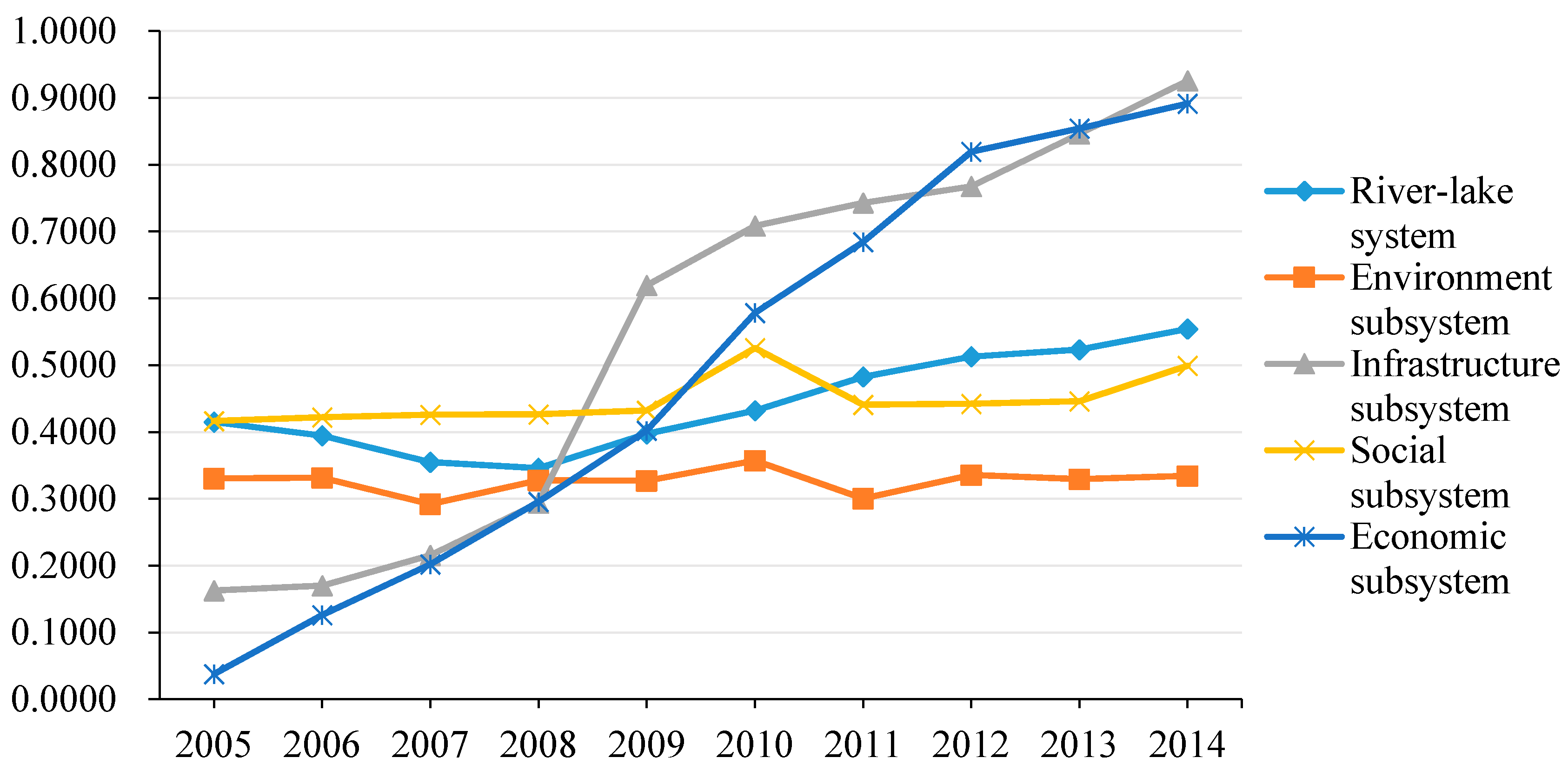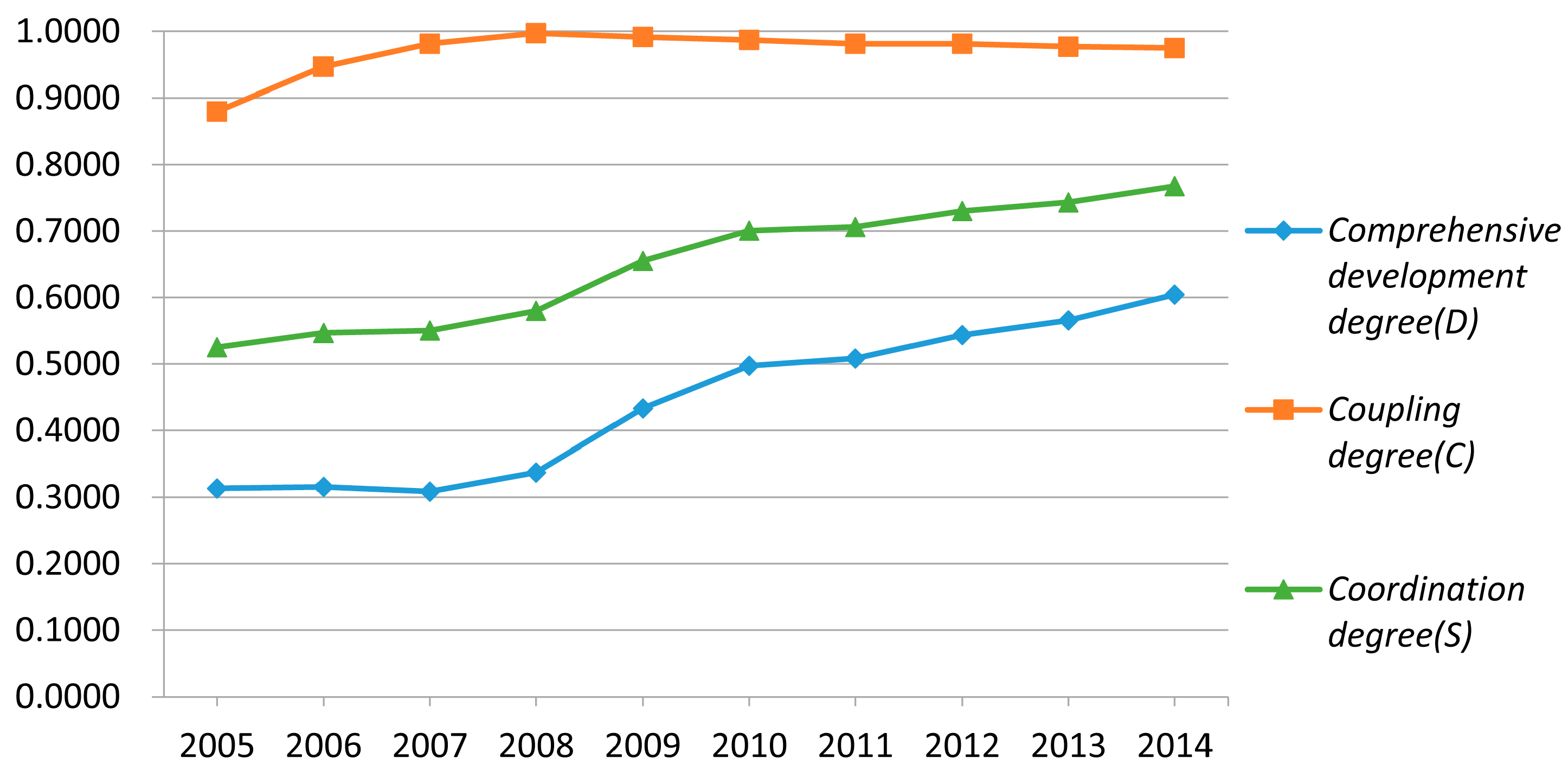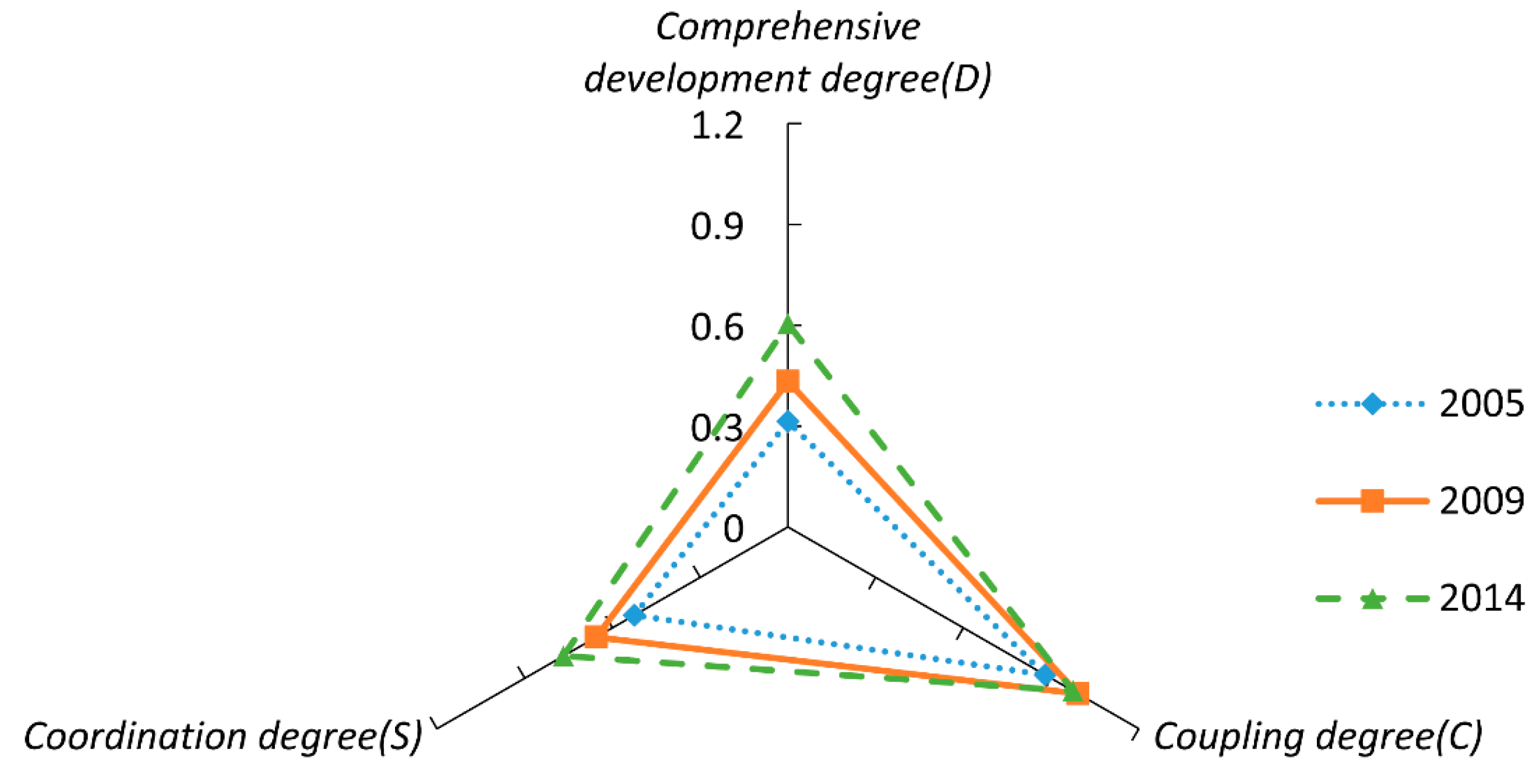The Evolution of River–Lake and Urban Compound Systems: A Case Study in Wuhan, China
Abstract
:1. Introduction
2. Methods
2.1. River–Lake and Urban Compound System
2.2. Basic Indicators of the Compound System
| System | Indicator | Indicator Type |
|---|---|---|
| River–lake system | Quantity of channels | efficiency |
| Quantity of lakes and reservoirs | efficiency | |
| River network density (km/km2) | efficiency | |
| Environment subsystem | Total volume of water resource (100 million m3) | efficiency |
| Groundwater usage (10,000 m3/year) | cost | |
| Eco-environmental water consumption rate (%) | efficiency | |
| Sewage treatment rate (%) | efficiency | |
| Wetland coverage rate (%) | efficiency | |
| Infrastructure subsystem | Number of large and medium bridges | cost |
| Length of drainage pipelines (km) | efficiency | |
| Length of sewage pipelines (km) | efficiency | |
| Social subsystem | Waterfront landscape satisfaction (%) | efficiency |
| Water resources per capita (m3/people) | efficiency | |
| Urbanization rate (%) | cost | |
| Economic subsystem | Per capita GDP (Yuan) | efficiency |
| GDP output per unit water (10,000 Yuan/m3) | efficiency | |
| Investment in wastewater treatment (10,000 Yuan) | efficiency |
2.3. Indicator Normalization
2.4. Collaborative Development Model
2.5. Case Study

3. Results and Discussion
| System | Indicator | 2005 | 2006 | 2007 | 2008 | 2009 | 2010 | 2011 | 2012 | 2013 | 2014 |
|---|---|---|---|---|---|---|---|---|---|---|---|
| River–lake system | Quantity of channels | 193 | 186 | 189 | 165 | 149 | 157 | 162 | 166 | 171 | 171 |
| Quantity of lakes and reservoirs | 479 | 438 | 424 | 406 | 394 | 407 | 411 | 419 | 426 | 435 | |
| River network density (km/km2) | 1.2 | 1.2 | 1.2 | 1.1 | 1.0 | 1.1 | 1.4 | 1.5 | 1.6 | 1.9 | |
| Environment subsystem | Total volume of water resource (100 million m3) | 50.4 | 42.4 | 29.9 | 36.9 | 36.0 | 76.6 | 27.2 | 47.9 | 39.5 | 40.7 |
| Groundwater usage (10,000 m3/year) | 2055 | 2200 | 2260 | 2306 | 2385 | 2499 | 2558 | 2674 | 2734 | 2760 | |
| Eco-environmental water consumption rate (%) | 0.4 | 0.3 | 0.4 | 0.4 | 0.4 | 0.2 | 0.2 | 0.3 | 0.3 | 0.3 | |
| Sewage treatment rate (%) | 45.0 | 71.0 | 75.8 | 76.9 | 78.4 | 81.4 | 83.1 | 84.8 | 85.1 | 85.3 | |
| Infrastructure subsystem | Wetland coverage rate (%) | 30.0 | 28.5 | 26.8 | 23.6 | 21.0 | 21.7 | 25.5 | 26.1 | 28.3 | 32.1 |
| Number of Large and medium bridges | 9 | 10 | 12 | 12 | 12 | 13 | 13 | 14 | 15 | 15 | |
| Length of drainage pipelines (km) | 1730 | 1810 | 6126 | 6321 | 6592 | 7543 | 7909 | 8173 | 9010 | 9853 | |
| Length of sewage pipelines (km) | 467 | 632 | 1021 | 1839 | 2145 | 2573 | 2996 | 3348 | 3785 | 4061 | |
| Social subsystem | Waterfront landscape satisfaction (%) | 74.3 | 64.8 | 51.1 | 58.0 | 56.5 | 82.0 | 47.0 | 67.0 | 68.2 | 76.8 |
| Water resources per capita (m3/people) | 628.3 | 517.6 | 360.1 | 439.0 | 422.4 | 888.8 | 312.0 | 542.0 | 441.5 | 448.8 | |
| Urbanization rate (%) | 59.2 | 60.2 | 61.0 | 61.1 | 62.1 | 62.7 | 63.7 | 64.0 | 64.7 | 65.3 | |
| Economic subsystem | Per capita GDP (Yuan) | 26,548 | 30,921 | 36,347 | 46,035 | 51,144 | 58,961 | 68,315 | 79,482 | 89,000 | 98,527 |
| GDP output per unit water (10,000 Yuan/m3) | 74.9 | 86.1 | 100.8 | 111.4 | 125.3 | 150.4 | 169.5 | 183.5 | 205.6 | 223.8 | |
| Investment in wastewater treatment (10,000 Yuan) | 93.2 | 132.6 | 191.8 | 191.8 | 191.8 | 205.9 | 227.4 | 229.3 | 254.3 | 260.3 |
| for | for | for | for | for | |||||||||||||||||||||
|---|---|---|---|---|---|---|---|---|---|---|---|---|---|---|---|---|---|---|---|---|---|---|---|---|---|
| 0.36 | 0.27 | 0.38 | 0.19 | 0.16 | 0.22 | 0.19 | 0.25 | 0.30 | 0.37 | 0.32 | 0.34 | 0.37 | 0.28 | 0.33 | 0.34 | 0.36 | 0.37 | 0.22 | 0.21 | 0.13 | 0.08 | 0.37 | 0.20 | 0.29 | 0.15 |



4. Conclusions
Acknowledgments
Author Contributions
Conflicts of Interest
References
- Macklin, M.G.; Lewin, J. The rivers of civilization. Quat. Sci. Rev. 2015, 114, 228–244. [Google Scholar] [CrossRef]
- Turner-Gillespie, D.F.; Smith, J.A.; Bates, P.D. Attenuating reaches and the regional flood response of an urbanizing drainage basin. Adv. Water Resour. 2003, 26, 673–684. [Google Scholar] [CrossRef]
- Tang, Z.; Engel, B.A.; Pijanowski, B.C.; Lim, K.J. Forecasting land use change and its environmental impact at a watershed scale. J. Environ. Manag. 2005, 76, 35–45. [Google Scholar] [CrossRef] [PubMed]
- Gregory, K.J. The human role in changing river channels. Geomorphology 2006, 79, 172–191. [Google Scholar] [CrossRef]
- Meng, X.; Zhang, Y.; Yu, X.; Zhan, J.; Chai, Y.; Critto, A.; Li, Y.; Li, J. Analysis of the temporal and spatial distribution of lake and reservoir water quality in China and changes in its relationship with GDP from 2005 to 2010. Sustainability 2015, 7, 2000–2027. [Google Scholar] [CrossRef]
- Van Stokkom, H.T.C.; Smits, A.J.M.; Leuven, R. Flood defense in the Netherlands—A new era, a new approach. Water Int. 2005, 30, 76–87. [Google Scholar] [CrossRef]
- Kayser, G.L.; Moriarty, P.; Fonseca, C.; Bartram, J. Domestic water service delivery indicators and frameworks for monitoring, evaluation, policy and planning: A review. Int. J. Environ. Res. Public Health 2013, 10, 4812–4835. [Google Scholar] [CrossRef] [PubMed]
- Cook, C.; Bakker, K. Water security: Debating an emerging paradigm. Glob. Environ. Change-Hum. Policy Dimens. 2012, 22, 94–102. [Google Scholar] [CrossRef]
- Gao, Y.; Wu, Z.; Lou, Q.; Huang, H.; Cheng, J.; Chen, Z. Landscape ecological security assessment based on projection pursuit in pearl river delta. Environ. Monit. Assess. 2012, 184, 2307–2319. [Google Scholar] [CrossRef] [PubMed]
- Cui, B.; Wang, C.; Tao, W.; You, Z. River channel network design for drought and flood control: A case study of Xiaoqinghe River basin, Jinan City, China. J. Environ. Manag. 2009, 90, 3675–3686. [Google Scholar] [CrossRef] [PubMed]
- Gurnell, A.M.; Shuker, L.; Lee, M.; Boitsidis, A.J. Gradients in the biophysical structure of urban rivers and their association with river channel engineering. River Res. Appl. 2012, 28, 908–925. [Google Scholar] [CrossRef]
- Allan, J.D.; Erickson, D.L.; Fay, J. The influence of catchment land use on stream integrity across multiple spatial scales. Freshw. Biol. 1997, 37, 149–161. [Google Scholar] [CrossRef]
- Billen, G.; Garnier, J.; Ficht, A.; Cun, C. Modeling the response of water quality in the Seine River Estuary to human activity in its watershed over the last 50 years. Estuaries 2001, 24, 977–993. [Google Scholar] [CrossRef]
- Gregory, K.J. Urban channel adjustments in a management context: An Australian example. Environ. Manag. 2002, 29, 620–633. [Google Scholar] [CrossRef]
- Chin, A. Urban transformation of river landscapes in a global context. Geomorphology 2006, 79, 460–487. [Google Scholar] [CrossRef]
- Kaushal, S.S.; Belt, K.T. The urban watershed continuum: Evolving spatial and temporal dimensions. Urban Ecosyst. 2012, 15, 409–435. [Google Scholar] [CrossRef]
- Butler, S.; Webster, T.; Redden, A.; Rand, J.; Crowell, N.; Livingstone, W. Using remote sensing to identify changes in land use and sources of fecal bacteria to support a watershed transport model. Water 2014, 6, 1925–1944. [Google Scholar] [CrossRef]
- Dutta, D.; Wilson, K.; Welsh, W.D.; Nicholls, D.; Kim, S.; Cetin, L. A new river system modelling tool for sustainable operational management of water resources. J. Environ. Manag. 2013, 121, 13–28. [Google Scholar] [CrossRef] [PubMed]
- Lv, H.; Xu, Y.; Han, L.; Zhou, F. Scale-dependence effects of landscape on seasonal water quality in Xitiaoxi Catchment of Taihu basin, China. Water Sci. Technol. 2015, 71, 107–114. [Google Scholar] [CrossRef] [PubMed]
- Toosi, S.L.R.; Samani, J.M.V. Evaluating water transfer projects using analytic network process (ANP). Water Resour. Manag. 2012, 26, 1999–2014. [Google Scholar] [CrossRef]
- Qiu, D.R.; Wu, Z.B.; Liu, B.Y.; Deng, J.Q.; Fu, G.P.; He, F. The restoration of aquatic macrophytes for improving water quality in a hypertrophic shallow lake in Hubei Province, China. Ecol. Eng. 2001, 18, 147–156. [Google Scholar] [CrossRef]
- The Wuhan Statistics Yearbook (2005–2014). Available online: http://acad.cnki.net/Kns55/oldnavi/n_item.aspx?NaviID=4&BaseID=YWHTJ&NaviLink=%e6%a3%80%e7%b4%a2%3a%e6%ad%a6%e6%b1%89-%2fKns55%2foldnavi%2fn_list.aspx%3fNaviID%3d4%26NaviQueryID%3d0%7c%e6%ad%a6%e6%b1%89%e7%bb%9f%e8%ae%a1%e5%b9%b4%e9%89%b4 (accessed on 6 August 2015).
- Wuhan Water Resources Bulletin (2005–2014). Available online: http://www.whswj.com/News/default.asp?cataid=25 (accessed on 3 August 2015).
© 2015 by the authors; licensee MDPI, Basel, Switzerland. This article is an open access article distributed under the terms and conditions of the Creative Commons by Attribution (CC-BY) license (http://creativecommons.org/licenses/by/4.0/).
Share and Cite
Wang, W.; Pilgrim, M.; Liu, J. The Evolution of River–Lake and Urban Compound Systems: A Case Study in Wuhan, China. Sustainability 2016, 8, 15. https://doi.org/10.3390/su8010015
Wang W, Pilgrim M, Liu J. The Evolution of River–Lake and Urban Compound Systems: A Case Study in Wuhan, China. Sustainability. 2016; 8(1):15. https://doi.org/10.3390/su8010015
Chicago/Turabian StyleWang, Wei, Melissa Pilgrim, and Jinan Liu. 2016. "The Evolution of River–Lake and Urban Compound Systems: A Case Study in Wuhan, China" Sustainability 8, no. 1: 15. https://doi.org/10.3390/su8010015
APA StyleWang, W., Pilgrim, M., & Liu, J. (2016). The Evolution of River–Lake and Urban Compound Systems: A Case Study in Wuhan, China. Sustainability, 8(1), 15. https://doi.org/10.3390/su8010015






